Everyone has a sexual orientation and gender identity! Reflect on your gender and sexuality. What words would you use to describe your gender identity and sexual orientation? How would these be interpreted by others? The SOGI (Sexual Orientation and Gender Identity) Education mandate includes nurturing a welcoming culture and learning environment to enhance language, curriculum, and pedagogical practices regarding sexual orientation and gender identity. At a SOGI-inclusive school, students’ gender does not limit their interests and opportunities, and their sexual orientation and how they understand and express their gender are welcomed without discrimination. How does social constructionism dictate how we see ourselves as gender beings? Why do most people think there are only two genders? In the following video from Origin Of Everything, Danielle Bainbridge provides a detailed analysis of the origin of gender.
Gender is worldly construction of the way we view ourselves. Various cultures around the world believe there are more than two genders. Some cultures create social constructs that are dynamic and fluid, and other cultures reduce gender to science and biology. Our gender will always be influenced by the social constructions of the context we live in, the society in which we are raised and the institutions we attend. On every continent, a variety of cultures have recognized, revered, and integrated more than two genders for all of recorded history. Prior to the colonization of Indigenous land and the introduction of western European social constructs, gender diversity was widely accepted and celebrated in many cultures around the world. The construction of a gender binary has shaped modern societies, and the idea of gender fluidity and expression has unfortunately been suppressed, yet there are some cultures that still honour these ancient traditions today.
SOGI 1 2 3 helps educators make institutions inclusive and safe for students of all sexual orientations and gender identities. SOGI 1 2 3 Inclusive Environments has digital tools of all sizes for learning individually and collectively. Through inclusive videos and presentations, educators can move their conversations from the “why” to the “how” of SOGI-inclusive education— through a workshop, at a staff meeting, or as a recommendation to a curious parent, the SOGI 1 2 3 Pro-D resource page is a useful digital resource for everyone. We can create gender-queer spaces by promoting a SOGI-inclusive environment. It’s important for schools to be inclusive and safe gender-queer spaces for students of all sexual orientations and gender identities. Fostering a SOGI-inclusive environment means:
- Speaking about SOGI in a way that makes every student feel like they belong
- Not limiting a person’s potential based on their biological sex and how they understand or express their gender
- Welcoming everyone without discrimination, regardless of their sexual orientation or gender identity
On the following videos, reflect on what is our role as educators to create and support gender-queer spaces? What is and how can a SOGI-inclusive environment foster gender-queer spaces?
Dr. Judith Butler is an iconic post-structuralist philosopher and gender theorist whose groundbreaking work has been highly influential in the fields of feminist theory and philosophy. She has received countless awards for her teaching and scholarship, including a Guggenheim fellowship, a Rockefeller fellowship, Yale’s Brudner Prize, and an Andrew W. Mellon Foundation Distinguished Achievement Award. When you think of gender performativity, you have Judith Butler to thank. In the philosophers best-known work Gender Trouble: Feminism and the Subversion of Identity, Dr. Butler discusses gender as performance, which has radically changed how we think about gender, not as an enduring characteristic of a person, but a constant creation the doing of gender.
In the video “Your Behavior Creates Your Gender”, Judith Butlers implies that nobody is born one gender or the other. How can this concept help create gender-queer spaces? What does it mean that gender is performative? How should this notion of gender performativity change the way we look at gender?
The Surprising History of Men in Heels. From their origins as an equestrian riding tool to the halls of Versailles, men’s heels once symbolized power, wealth, and masculinity. Men generally stopped wearing heels when they became a staple of women’s fashion in the mid-18th century. When you think of high heels today, your first thoughts certainly center around women. From the Beatles and David Bowie to Kiss and Prince, the male heel is still very much part of our cultural identities and opposes social constructions around gender. Through their gender expression, the queer community is challenging gender norms and claiming their identity. You may ask yourself, what is the difference between gender identity and expression:
- Gender Identity is the way we see ourselves, our gendered body. It is internal and individual.
- Gender Expression is the way we externally display our gender, usually through our dress demeanour and social behaviour.
In the following video from Origin Of Everything, Danielle Bainbridge explains how high heels went from being for manly men to a fashion accessory for women. How much of what we wear are culturally coded rationalizations? How does it relate to our gender identity and gender expression? What do you think of this gender-flip?
We still live in a world of gender-dependent standards and gender expectations. Many companies, institutions and programs continue to have gender policies like a short hair policy for males. For many people, hair is a reflection of their identity and does not determine their gender. In many Indigenous cultures, hair has spiritual importance and cutting hair has been used as a weapon against Indigenous peoples. The shaming of Indigenous children for their long hair can be traced back to residential schools, where they had their hair cut short immediately after they arrived. It was a method used by settlers to further its colonial and assimilationist agenda. These days, Indigenous families are speaking out against racial and homophobic slurs thrown at boys and men for having long, braided hair.
Boys with Braids is dedicated to sharing the teachings of why boys, men and elders wear braids. It is Inspired by an event created by Michael Linklater, who is Nehiyaw (Cree) from Thunderchild First Nation, saying he wears a braid to honour his ancestors and his culture. Reflect on the difference between your gender identity and your identity expression. How have gender expectations and standards shaped our identity?
Dr. Toni Schmader is one of the people at UBC who is shaping the future by researching gender disparities. As a professor and Canada Research Chair in Social Psychology, she’s been diligently working to determine how educating people about their implicit biases can make a difference in changing social constructs in our culture. Unfortunately, it is a rare sight to see a woman working in a STEM field (science, technology, engineering, mathematics). Women are outnumbered 3 to 1 by their male counterparts. Dr. Toni Schmader reveals the deep-rooted biases and gender stereotypes affecting women. She states that to change these biases, you need to start young. Later on, it’s more difficult to change your perception.
The following video produced by Ecology Project International shows how to engage more young girls in STEM through five actions! After watching, think of what social constructions prevent girls from entering STEM fields? How do education and culture perpetuate inequality? How can we help our students break gender stereotypes and engage in what they are motivated to do?
Dr. Mary Bryson says our students need a love that recognizes: “you know who you are and you know what is your gender identity right now, today.” Our job as educators is to listen to our students, find what they care about and create spaces where they can express who they are. Boni Wozolek and Reagan P. Mitchell (2018) state “gender-queer spaces are a necessary step toward re-thinking safety and equity for marginalized youth in school”, as “tools for a multiplicity of ontological and epistemological mobility against monolithic ideals of being and knowing.” Malins (2016) ends her study of inclusive education reminding us that “the silence has to stop. It’s time to embrace conversations that truly meet the needs of all students and families.” Gender identity justice for everyone!
sj Miller, a trans* (a)gender award-winning teacher, writer, activist, and scholar, a literacy specialist whose emphasis is on social justice and gender identity in pre-K through university-level teaching. sj’s research focuses on trans* + disciplinary perspectives on social justice and marginalized student literacies and identities with an emphasis on gender identity. sj’s TEDMed Talk reminds us how exploring nonconforming gender identities can be particularly hard, but everyone needs to be treated with dignity. sj Miller explores social justice and gender identity for kids and young adults and believes that we need to start building critical literacy and compassion around the complex topic of gender in schools and beyond. We are the gender identity revolution!
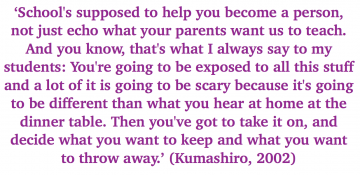

Let’s create and support gender-queers spaces were all students recognize their existence. Let’s push the boundaries of binary gender norms. Change perceptions, not people. Ruffle feathers!!!
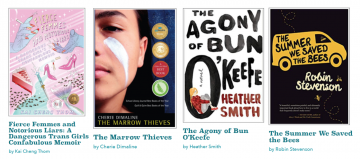
Fabulous Digital Resources that foster Gender-Queer Spaces!
- Jazz Jennings Reads “I Am Jazz”- Human Rights Campaign. Transgender teenage activist and HRC Youth Ambassador Jazz Jennings reads her award-winning book “I Am Jazz” aloud!
- There’s Heart Here– A short-film that follows three indigenous members of the Two-Spirit and Queer community as they journey toward self-acceptance, supportive healthcare, and communities that celebrate them. Produced by the Northwest Portland Area Indian Health Board
- Students Share Their LGBTQ history Icons- GLSEN works to make schools safe and more inclusive for LGBTQ students. GLSEN has the resources for you to create gender-queer spaces! Find a full LGBTQ history timeline!
- Sex Assigned at Birth and Gender Identity: What Is The Difference?- Amaze provides real sex ed info in fun, animated videos that give you all the answers you actually want to know about sex, your body and relationships.
- The Drag Alphabet- Nina West. RuPaul’s Drag Race alum brings drag to the children’s space. Making a queer alphabet with kids, for kids because representation matters!
- The Gender Unicorn- Trans Students Educational Resources provide trans-related infographic series. They encourage you to share and print the graphics available!
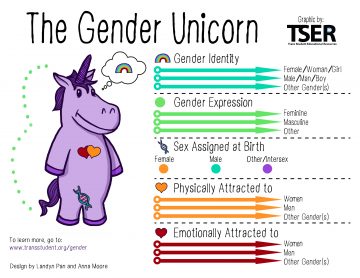
- All About The Facts– Options for Sexual Health provides information about the healthy sexuality of all. Options currently offer services in British Columbia. They care All About Choice: offer current sexual and reproductive health care, information, and education from a feminist, pro-choice*, sex-positive perspective.
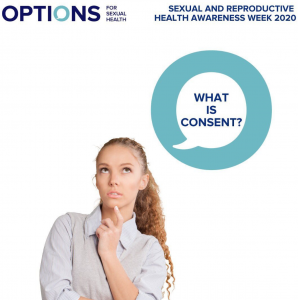

- Sexual & Gender Diversity– Teaching Sexual Health is an innovative website developed by Alberta educators and health professionals offering up-to-date, evidence-based information and strategies for teachers and educators.

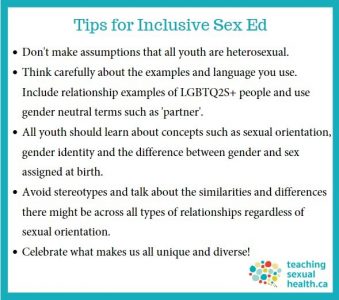
Glossary
DISCLAIMER: While UBCx Gender and Sexuality: Applications in Society have tried to develop a comprehensive glossary of terms, the nature of language is malleable and everchanging. Different words take on different meanings in different societies, so please keep this in mind as you peruse this list.
Ableism: A conscious or unconscious prejudiced set of thoughts, attitudes, and/or practices that discriminates against people who have visible or invisible disabilities.
Agender: Identifying as neither male nor female.
Ally: An individual who offers support. LGBTQ allies are often non-LGBTQ individuals who support equality for sex and gender minority populations.
Asexual: Without sexual feelings towards others.
Aromantic: Without romantic feelings towards others.
Assigned sex/ Biological sex: The sex to which an individual is consigned at birth. Often seen as a binary (male/female) but as there are numerous combinations of chromosomes, hormones, and primary/secondary sex characteristics, making it more accurate to view this as a spectrum.
Bisexual: Person who is sexually attracted to both women and men.
Cisgender: A person whose gender identity and biological sex assigned at birth align (e.g., man and assigned male at birth).
Coming Out: An individual’s self-disclosure of their sexual orientation or of their gender identity
Cross-Dressing: The wearing of clothes, accoutrements, cosmetics, accessories etc. that are, within a specific culture, typically associated with the opposite sex.
Discrimination: Treating an individual or a group of individuals differently because of a prejudiced or prejudicial viewpoint.
Drag: A theatrical term from the 19th Century originally used to describe men wearing women’s clothing. Since then, the term has broadened to include drag artists which may identify as drag kings or drag queens. *NB; drag is theatrical and often exaggerated and is NOT to be confused with cross-dressing or a transgender person’s presentation.
Emotional Labour: A term coined by sociologist Arlie Hochschild in 1983, describing the process or task of managing one’s own and other’s emotions to meet the requirements of a job or the social requirements of daily life. Disproportionately, emotional labour is done by women.
FTM/F2M/FtM and MTF/F2M/FtM: Acronyms for Female to Male and Male to Female respectively. Refers to a transition in gender identity and/or expression.
Gay: Adjective used to indicate same-sex attraction, identity or behaviour.
Gender: A complex interrelationship between an individual’s biological gender, gender identity, and gender expression. Gender is a social and cultural construct based on the characteristics that a society or culture perceives to be ‘masculine’ or ‘feminine’.
Gender-Based Analysis: To carry out an analysis of any scenario so as to focus specifically on gender.
Gender expression: The external display of one’s gender identity, through a combination of dress, demeanour, social behaviour, and other factors in a particular cultural context. A person’s name and pronoun are common ways of expressing gender.
Gender identity: Internal and individual experience of gender. Gender identity involves how people perceive themselves, and tends to be based on how much they align or do not align with what they understand their options for gender to be. Common identity labels include man, woman, agender, genderqueer, trans, and more.
Gender Non-Conforming: Describes modes of gender identity and expression where a person does not express their gender identity in typical ways relative to their sex assigned at birth.
Genderqueer: Not ascribing to or identifying with conventional gender distinctions. Also known as Non-binary.
Heteronormativity: The discriminatory assumption that the norms or values common to being heterosexual apply to all other sexualities.
Heterosexism: A form of discrimination that grants preferential treatment to heterosexual people. Heterosexism reinforces the idea that heterosexuality is somehow better or more ‘natural’ or ‘correct’ than queerness.
Heterosexual: a person how is romantically and/or sexually attracted to a person of the opposite gender.
Homosexual: A historic term from an era of pathologization of same-sex relationships that most contexts is now considered inappropriate and stigmatizing for usage to describe an individual who is romantically and/or sexually attracted to people of their own sex.
Intersectionality: An analytic framework which works from the premise that various forms of social stratification, such as age, class, disability, gender, race, and sexual orientation do not exist independently from each other, but are interlocked together. Intersectionality attempts to identify how overlapping and interdependent systems of discrimination or disadvantage impact those who are most marginalized in society.
Intersex: General term used to describe individuals whose chromosomes, hormones, or genitals do not align with typical characterizations of male or female.
Lesbian: A woman whose primary sexual orientation is to be attracted to people of the same sex.
LGBTQIA+: An inclusive acronym for marginalized sexual and gender identities. (Lesbian, Gay, Bisexual, Trans, Queer, Intersex, Asexual) The + sign is an acknowledgement that the list is not complete, and other gender identities are acknowledged, accepted, and welcome.
Marginalization: The treatment of a person, group, or concept as insignificant or peripheral, and the process whereby something or someone is pushed to the edge of a group and relegated to lesser importance. Marginalized people are, by definition, located at the edge, beyond boundaries, on the outside.
Miscegenation: People from different racial groups having children. Anti-miscegenation laws refer to laws that enforced racial segregation, banning marriage and/or sex between races. These were applied in some states in the US up until 1967.
Misandry: Contempt, dislike, mistrust, hatred, and/or disgust for men.
Misogyny: Contempt, dislike, mistrust, hatred, and/or disgust for women. Is not exclusive to males.
Minority stress: The collectivized stress faced by members of stigmatized minority groups that can impact mental health, well-being, and social functioning.
Monogamy: An intimate relationship with a single partner, or in the case of serial monogamy, a single partner at any one time.
Neocolonialism: The use of cultural, economic, political, or other pressures to control or influence other countries.
Neoliberalism: The 20th Century resurgence of 19th Century market-oriented policies and ideas such as austerity, deregulation, free trade, privatization, and reductions in government spending in order to increase the role of the private sector and the prioritization of profit in the economy and society.
Non-binary: A broadly inclusive term describing individuals who do not conform to the masculine/feminine binary.
Oppression: The imposition of unjust treatment, norms and values and/or control.
Pansexual/Pansexuality: A sexual and/or romantic attraction to another adult–where biological sex, gender, or gender identity are not of decisive importance.
Passing: In the context of gender and sexuality, passing means to be accepted as cisnormative and/or as heteronormative.
Patriarchy: A system of social organization in which power circulates amongst men and, largely, excludes women from power.
Pre-Op, Post-Op, Non-operative, Non-Op, or Non-Surgical: Terms used to describe gender-affirming medical interventions like sex reassignment surgery to align the body with gender identity. It is important to note that these terms are not a measure of an individual’s ‘trans-ness’.
Polyamory: Intimate relationships with more than one partner—with the consent of all partners. Stands distinct from variations of monogamy (e.g. serial monogamy, affairs, swinging, playing) and polygamy.
Polygamy: A relationship type where a person marries multiple spouses. Polyandry refers to when a woman takes on multiple husbands, polygyny refers to a man takes on multiple wives. This term is mostly used in heterosexual relationships.
Prejudice: An opinion or position that pre-judges a person, a situation, an argument, or a group of people. A form of discrimination.
Privilege: Rights, advantages, or invulnerability exclusively accessible to a particular individual or group of people.
Pronouns: Use of pronouns to distinguish different gender identities ie. They/them/theirs/he/him/his/she/her/hers/ze/zir/zirs
Queer: A catchall term used to describe people who do not conform to the gender binary, heteronormativity, and/or cisnormativity.
Queer theory: A form of literary and cultural study and analysis that challenges conventional categories of gender and sexuality.
Sexism: Prejudice, stereotyping, or discrimination on the basis of sex.
Sexuality: The biological, erotic, emotional, physical, social, and/or spiritual feelings and behaviours involved in the way people experience and express themselves sexually.
Sexual Behaviour: Any activity that produces sexual arousal.
Sexual Orientation: The way(s) in which a sexual identity relates (romantically, erotically, emotionally) to the gender(s)/sex(es) to which they are attracted.
Sex Reassignment Surgery: (also known as gender reassignment surgery, gender confirmation surgery, genital reconstruction surgery, gender-affirming surgery, or sex realignment surgery) A range of surgical procedures that alter anatomical traits to provide physical traits more appropriate to the identified gender identity and functioning of the individual.
Stereotype: A fixed and oversimplified image or idea—a caricature.
Social Justice: A concept of fair and just relations between the individual and society in terms of the access to, and distribution of, wealth, opportunities, and privileges within that society.
Straight: Heterosexual; may or may not signify heteronormativity.
SWERF: An acronym for Sex Worker Exclusionary Feminism. An ideology that argues that sex workers contribute to the violence, exploitation and sexual objectification of women. Aligned with TERF ideology.
Transition: The (social, medical, psychological, surgical, chemical) process of changing one’s gender presentation and/or sex characteristics to match-up with one’s internal sense of gender identity.
Transgender (Trans): An individual whose gender identity does not correspond with their assigned sex.
Transsexual: a term typically used by some people who see their transition in binary terms, as a progression from a gender identity consistent with the sex assigned at birth to the other gender.
trans*: a prefix or adjective used as an abbreviation of transgender, derived from the Greek word meaning “across from” or “on the other side of.” Many consider trans* to be an inclusive and useful umbrella term. Trans (without the asterisk) is most often applied to trans men and trans women, and the asterisk is used more broadly to refer to all non-cisgender gender identities, such as agender, cross-dresser, bigender, genderfluid, gender**k, genderless, genderqueer, nonbinary, nongender, third gender, trans man, trans woman, transgender, transsexual and two-spirit.
TERF: An acronym for Trans Exclusionary Radical Feminist. An ideology that argues that self-affirmed gender identities (i.e. trans) are invalid. Aligned with SWERF ideology.
Two-Spirit: A term used by some indigenous North American first peoples to describe individuals in their communities whose gender identity, expression and roles in their cultures and communities are not cisnormative.
Works Cited
Banks, W. (2009) Literacy, Sexuality, and the Value(s) of Queer Young Adult Literatures. Urbana, IL: National Council of Teachers of English- The English Journal Vol. 98, No. 4, pp. 33-36.
Kumashiro, K. (2002). Troubling education: Queer activism and anti-oppressive pedagogy. New York, N.Y.: RoutledgeFalmer
Malins, P. (2016). How inclusive is “inclusive education” in the Ontario elementary classroom?: Teachers talk about addressing diverse gender and sexual identities. Teaching and Teacher Education, 54, 128-138. doi:https://doi.org/10.1016/j.tate.2015.11.004
Wozolek, B. & Mitchell, R.P. (2018) Plastic or phalloplasty? Negotiating masculinity and (cis)gender norms in schools and the academy, Journal of Curriculum and Pedagogy, 15:3, 318-322, DOI: 10.1080/15505170.2018.1525451